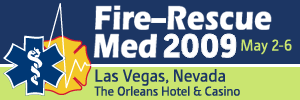By Deputy Chief Gary Ludwig
EMS Section Chairman of the IAFC
Related Resources: |
One of the most frequent questions I’m asked at conferences is, “What on the horizon is going to have the biggest impact on fire-based EMS?” This is not a simple one to answer as there any many things impacting fire-based EMS.
What is clear, of course, is the profound impact that the economic crisis is having on fire-based EMS funding and service delivery. The fact is that it will take a long time before the credit and housing markets are ironed out, unemployment goes down and people go back to work.
Until that happens, fire-based EMS will be challenged. Among the top five challenges facing departments in the immediate future are:
1. Decreasing Tax Revenues
A down economy equates to decreasing tax revenues. For many fire-based EMS systems, a primary source of funding comes from sales tax revenues. I continue to hear many reports of fire departments that are laying people off, closing stations and reducing companies, including ambulances. One response has been that more departments are looking at EMS billing to make up the shortfall.
2. Increasing Call Volumes
| The key to staying ahead of the curve and to be better prepared to meet challenges such as those outlined here is to read journals, attend conferences and network with other professionals. In May, Fire-Rescue Med will be offering such an opportunity to do that. Session topics will include public and private integration challenges, embracing technology for fire-based EMS programs, and recruiting and retaining EMTs, and illness prevention programs. The general session will feature Dr. Henry Lee, one of the world’s foremost forensic scientists. If you are a current or aspiring fire chief officer who manages or oversees an EMS system, I encourage you to register for the event, which takes place May 4-6 at the Orleans Hotel in Las Vegas. |
When people lose their jobs, many also lose their health insurance. When that happens and people get sick or injured, they call 911. And since they do not have health insurance, don’t expect much in terms of EMS transport reimbursement. Couple that with the increasing health-care needs of millions of baby boomers and predictions that Medicare funding will run out in 2019. Many fire-based EMS systems rely on Medicare funding to supplement their tax revenue. Over the next several years, I would expect the call volume in communities in Florida and Arizona to rise significantly.
3. Implementing Education Standards
After an approximately three-year process, new EMS education standards are about to be released. The question now becomes this: how will those standards be implemented? The new standards will now standardize four different levels (Emergency Medical Responder, EMT, Advanced EMT, and Paramedic) of medical training. There are still many different titles and scopes of practice among the 50 states and the US territories. If these four levels of licensure and scopes of practice are to be standardized, states will have to make adjustments.
4. Differing Treatment Modalities
Expect to see future cardiac arrest victims who are cooled with induced hypothermia. Studies have shown increased hospital discharge rates of cardiac arrest patients who are neurologically intact after their body has been cooled. The cooling process starts in the field and continues after delivery at the hospital.
5. Recognizing In-Field STEMIs
Another area that will change fire-based EMS in the near future is the whole concept of awareness and recognition of in-field STEMIs (ST Elevation Myocardial Infarction). Although many departments are following these concepts of recognizing STEMIs in the field and notifying the hospital prior to their arrival, many systems have not totally embraced this practice. Within the next few years, expect wide-spread acceptance and even changes in procedures of by-passing emergency rooms and heading straight to the cath lab with the patient.
 |
Gary Ludwig currently serves as a deputy fire chief for the Memphis, Tenn., Fire Department. Chief Ludwig has 31 years of fire and rescue experience and started his career in St. Louis, where he retired as the Chief Paramedic from the St. Louis Fire Department. He also is Chairman for the EMS Section of the International Association of Fire Chiefs, and writes monthly columns in Firehouse Magazine and the Journal of Emergency Medical Services (JEMS). He has authored more than 400 articles in professional trade journals and has lectured at more than 225 fire and EMS conferences in 42 states. He has a master’s degree in business and management and is a licensed paramedic. He can be contacted at gary.ludwig@memphistn.gov.












